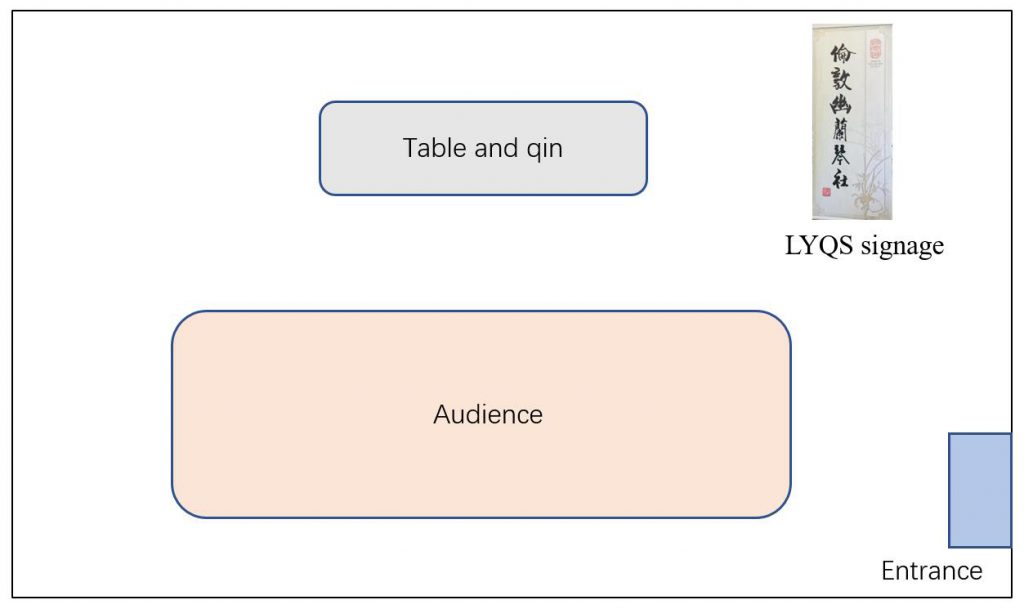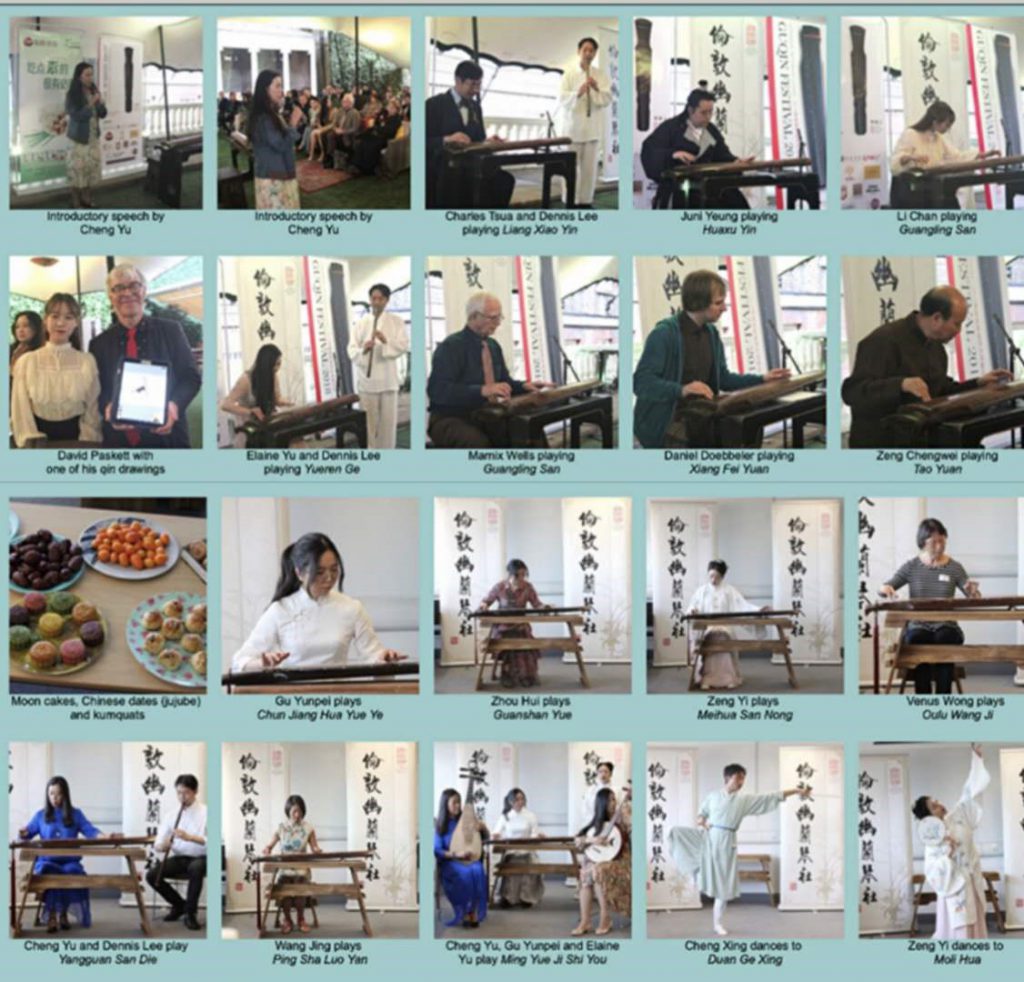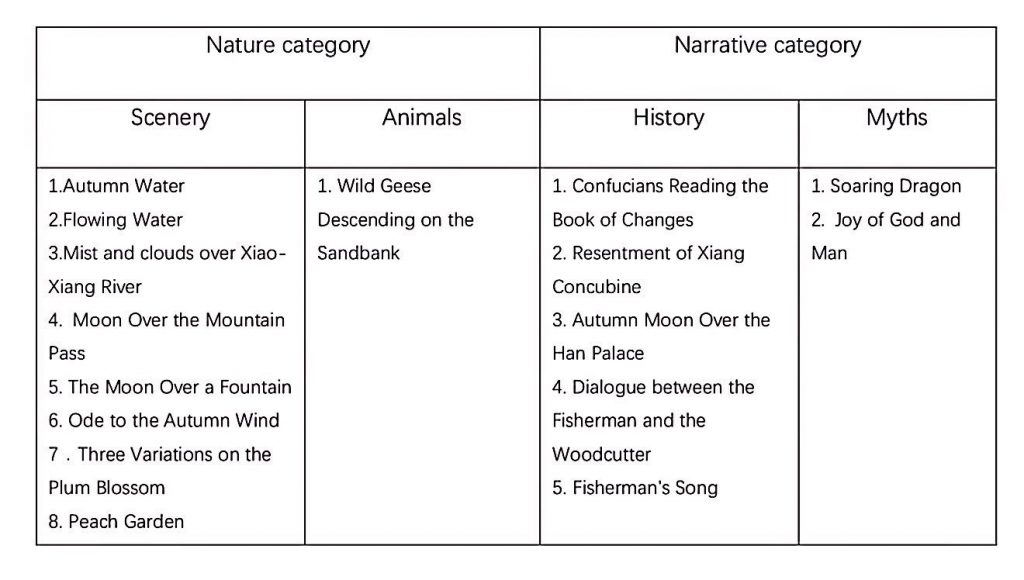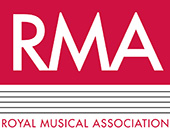
How cultural exchanges behave like, and what will happen a group of traditional Chinese music aficionados meet each others? In this month’s student blog, Teng Chen will discuss about the Youlan Qin Society (幽蘭琴社) and its regular activity (the ‘Yaji’) in Central London. Teng is a graduate ethnomusicology student at King’s College London, and she expect to continue her PhD research in Sino-Western music encounter at the University of Southampton.
Introduction
The guqin (古琴) or qin (琴), also known as a seven-string zither, is a Chinese national musical stringed instrument with a rich history (Chen, 2015). According to relevant documents, the guqin existed in the Zhou dynasty from the 11th century BC to the 8th century BC[1]. It not only has a long history, but also has a rich cultural context, which has attracted the attention of western scholars. Post 18th century, several western works on the guqin were produced (Garcia, 2018), in particular the book The Lore of The Chinese Lute (琴道) written by Dutch Sinologist Robert Hans van Gulik, which has a particularly authoritative influence in western sinology (ibid). With the increasingly close cultural exchanges between the East and West, where does guqin music and its significant cultural heritage stand in the Western world today? What is the degree of acceptance and response of Westerners when exposed to the guqin? In what way is the guqin, as a foreign culture, adopted and accepted in the West?
This essay will take Western learners in London You Lan Qin Society as the core subject of investigation, specifically a yaji (gathering of literati雅集) held by the Qin Society on November 20, 2018. An observational methodology and descriptive narrative will be harnessed to analyse the sparks from the collision of the cultural exchange between Eastern and Western music. Firstly, the author will discuss from the perspective of anthropology how people appreciate, learn and overcome various difficulties in their own way when they are exposed to music forms of different cultural origins. Secondly, from the perspective of sociology, the author will reflect on the spread of guqin music, its display platform, learning resources and other issues. Finally, following on from the above results, we will discuss the comparison and exchange of cultures, and look towards the future development prospects of guqin culture in the West through platforms as the London You Lan Qin Society provides.
Geographical location and activity environment
Founded on July 13, 2003, London You Lan Qin Society (hereinafter referred to as LYQS) is the first guqin cultural organisation in Europe[2]. Since its establishment, LYQS has settled on the tradition of holding a yaji once every two months. SOAS London University, located near Russell Square in central London, usually provides an activity space for the yaji, such as a classroom or conference room that can hold about 30-40 people.
Generally, there will be a London You Lan Qin Society sign on the right side of the platform area. A table and a guqin will be placed in the centre of the platform, which is the performance area. The seats in the classroom become a place for the participants to relax and enjoy the musical performances. The overall activity layout is roughly shown in Figure 1.
This particular yaji was on November 20, 2018 – the 103rd LYQS yaji.

Content and process of activity
If we trace the history of the yaji, we can find an early prototype in the first poetry collection in China, which was written in Book of Poetry in the 8th and 9th centuries BC (Shen, 2013). As it developed, yaji began to include elements such as: painting and calligraphy, poetry, drinking, tea, playing the qin. There were different preferences of activities in different historical periods, and so the content and form of yaji were also different (Xiong, 2005). The “yaji” mentioned in this essay, which is adopted by the LYQS, is a small informal concert with a relaxed atmosphere and not always containing all the activities of traditional yaji.

The yaji lasted for three hours, including the first half and the second half, with a 20-minute break in between. In the beginning, society president Cheng Yu made a brief welcome speech, which was followed by the performances. The players contributed a total of 19 pieces of music, most of which were slow and rich in melody, with some being relatively light. The musicians briefly introduced the name and background of their repertoire to the audience before they performed.
If we analyse 19 pieces played (as shown in figure 3) in this yaji, we can see that the ancient Chinese people preferred to express their feelings through natural themes when creating guqin works. This also reflects the musical narrative ability of the guqin.

Fieldwork interview and telephone interview
There is a degree of uncertainty when carrying out fieldwork, despite one’s preparations, which can be part of its charm, but can also cause unexpected turns. When I asked Ms Cheng for permission to carry out this project, she informed me that several western players were temporarily unavailable for personal reasons. As such, all of the players in this yaji were Chinese. (To address this deficiency, I visited two other western learners after the yaji.) Fortunately, the event attracted three local British viewers, who kindly agreed to be interviewed and provided valuable insight for this investigation.
The three Londoners had the following in common: they were non-music professionals; they were not aficionados of Chinese culture; this was the first time they have been in close contact with Chinese music. As such, the guqin was a completely foreign instrument to them. However, they differed in age and purpose of attendance – one was a retired man who was there to “learn more about Chinese culture”. The other two were a young man and woman who composed music and were there to capture elements of Oriental music to as inspiration for their works. Due to the differences between the three interviewees, their attitudes and opinions on the same question were a far cry from each other. Here are two of our conversations:
<1>
Author: Based on this small concert, what is your most direct feeling of guqin music or Chinese classical music?
Interviewee 1: I feel it is a balance between nature and art. It seems to convey a philosophical concept. It is peaceful and modest.
Interviewee 2: For me, what I hear more is the expression of emotion, or I am curious about the movement of playing.
<2>
Author: Through this experience, generally speaking, what do you think are the obvious differences between Eastern and Western music?
Interviewee 1: This (guqin) music is very humble and quiet, as oppose to western classical music is quite grand, usually it’s a display of wealth and prosperity.
Interviewee 2: It’s like comparing Chinese calligraphy with western paintings. They are totally different aesthetics. How profound the expression of Oriental music is, but for Westerners you have to find your own way to get in, because it’s not something you’re familiar with. For example, the underlying sense of melody and the music content of rhythm and melody are very different from Western music. I don’t feel the obvious rhythm in this (guqin) music.”
In fact, in a way, they all understood the guqin music to some extent. The answer to the question of whether guqin music conveys philosophy is positive. In ancient Chinese philosophy, the concept of “harmony between heaven, earth and mankind” is one of the most fundamental and core values, as The Book of Music in The Book of Rites [4] put forward: “Yue (樂music)[5], the sum of heaven and earth.” (Luo, 2010). One possible reason why the younger listeners perceived “balance between nature and art” is the natural timbre of the guqin. The concept of advocating for and respecting nature is also recorded in a large number of ancient documents (Zhang, 2012). As has been mentioned above, there are a large number of works with nature-based themes.
From these three Western listeners with minimal Chinese cultural experience, the feedback from their first contact with guqin music is relatively accurate. Although there is no consensus with regards to “music commonality” in academic discussions (Nettl, 1977), this practical example may provide fuel for further discussion.
The following interview was conducted after this yaji with two Western players with a keen appreciation of guqin culture, Englishmen Edward and Julian. Edward recalled first hearing guqin music when he was 15 years old. It was the background music to the Chinese ink painting cartoon “Feelings of Mountains and Waters” broadcast on the English Channel CCTV[6]. Later on, he majored in Chinese at college and obtained a master’s degree. Years later, by a friend’s recommendation, he attended one of LYQS’s yaji. From then on, he began to learn the guqin from Cheng Yu, and has been doing so for a year and a half since then.
The other gentleman, Julian, is the co-founder of LYQS, and his obsession with the guqin is remarkable. Talking about coming into contact with guqin music for the first time, Julian recalled buying a collection of Chinese national music records on a trip to Hong Kong in the late 1990s. Although there was only one guqin song among them, it left a particularly deep impression. After that, he began to collect records and books about the guqin, and started his self-study of the guqin. Speaking of his collection, he estimated that he owned over 200 CDs and even provided a photo of part of his collection (Figure 4).

Analysis from the perspective of anthropology and sociology
To summarise the following lines of thought can be laid out: First, heterogeneous cultures have considerable influence and attraction. For both Western listeners and players interviewed, the essential characteristics of guqin music, such as linearity, ethereality, and profoundness, are all quite different from the characteristics of music from their own cultures, such as harmony, lightness and amplitude ranges. It tends to be the contrast that first catches their attention. This phenomenon is reflected in Julian’s example. According to his description, many different Chinese instruments featured throughout the album. His attention, however, was drawn to the guqin in particular. My inference is that on that album, the guqin could well be the only instrument that did not show any traces of Westernisation.
Since the first half of the 20th century, the formation and composition theories of Chinese ethnicl instrumental music have gone through waves of reform. Musicians have had many a heated debate on whether the use of Chinese instruments should be Westernised (Chen, 2007), as the original blueprint for these reforms referred to Western orchestras (Lin, 2012). However, due to its quiet volume and suitability for self-learning, the guqin has avoided this reformative process.So it retains the properties of classical Chinese music in terms of its repertoire and timbre. This is, for Julian, the difference between the guqin and other musical instruments with varying degrees of Westernisation (whether he’s aware of it or not). The originality of guqin music, which is most evidently different from his Western cultural background, maybe its most attractive feature.
Secondly, cross-cultural communication requires diversified communication platforms. In Edward’s case, he was exposed to at least four different modes of communication — books, television, online media and yaji activities. These exchanges need to be supported by multiple forces from Eastern and Western cultural backgrounds and even promoted globally. For example, guqin was included in the second batch of the Intangible Cultural Heritage List in 2003[7]. This global certification has expanded its popularity and influence. For both the Chinese and for Westerners, it is easier to pay attention to the guqin from a psychological level (Golbeck and Hendler, 2004). For example, in August 2018, the first London international guqin art festival was held under the auspices of the National Art Council Foundation in cooperation with the Chinese Academy of Sciences, SOAS, University of London, Confucius Institute of London, London Chinese Orchestra and London Orchid Society[8]. These are inseparable from the joint efforts of diversified cooperation platforms.
Thirdly, continuity is key to retaining the “freshness” of niche music. Practitioners of guqin music, whether in China or in Western countries, are still a minority group. However, since the establishment of the LYQS, the yaji has been going strong – it was the 103rd yaji that was being observed. Due to the inherent limitations of data collection, it is difficult to know the number of people who have progressed from the audience to practising amateurs, and then from amateurs to players in the 15 years since the LYQS was established. However the continuity of this practice, at least, will provide a route for access to guqin music. How Edward started to learn the guqin is a good example.
Conclusion
Cross-cultural music communication is becoming more and more frequent in the context of globalisation. However, with the spread of Chinese classical music in the Western world, whether it can find acceptance or further develop remains to be seen. This essay takes the development of guqin culture in London as an example, through the observation of a yaji held by the London Youlan Qin Society, the reflection and feedback of the Western members of the audience, and the learning process of Western players. The potential for guqin music to step forward on the global stage of music is palpable. Its music is infectious. Through the guqin, one can feel the sounds of nature and the unique aesthetics of China. Some are obsessed with the music, and its timbre, and some regard it as a key to understanding Chinese culture. However, does having a wider audience and player base mean that this cultural heritage will be protected? Can ethnomusicology scholars in the East and West do more for this significant cultural touchstone with such a rich history, besides popularising it? What other steps in musical cooperation can be taken between the East and West? As one can see, there is plenty of work ahead for the guqin.
Bibliography
Alford, García, Jacob. C, and Geng, Hu and Zhang, Jing. Knowing Sound-Guqin Culture Companion. Bei Jing: Higher Education Press, (2018).
Chen, Wei. Art History of Erhu. Wu Hu: Anhui People’s Publishing House, (2007).
Chen, Yingshi. Musical temperament of Qin, Shanghai: Shanghai Conservatory of Music Press, (2015).
Geertz, Clifford. “Thick description: Toward an interpretive theory of culture. The interpretation of cultures: Selected essays (pp. 3-30).” New York, NY: Basic (1973).
Golbeck, Jennifer, and James Hendler. “Accuracy of metrics for inferring trust and reputation in semantic web-based social networks.” In International Conference on Knowledge Engineering and Knowledge Management, pp. 116-131. Springer, Berlin, Heidelberg, (2004).
Lin, Jing. “Musical Instruments From the 1950s to the Present Reform of Chinese Folk Instrumental ‘New Tradition’”, PhD diss., Xinjiang Normal University, (2012).
Liu, De. and Liu, Xiu. The Book of Music in The Book of Rites (the ancient book of the Western Han dynasty). Bei Jing: People’s Literature Publishing House, (reprinted in 1986).
Luo, Xiaoping. Ecological aesthetics – a new perspective that the beauty circle of music should pay attention to, PEOPLE’S MUSIC, Vol.12, pp.87, (2010)
Mazur, Rafał. “Music as a Tool for Self-Realization in Chinese Culture: Based on the Practice of Playing the Guqin.” (2015). URI: https://depot.ceon.pl/handle/123456789/6799
Ma, Weiheng. A probe into the beauty of guqin timbre, THE NEW VOICE OF YUE—FU (The Academic Periodical of Shenyang Conservatory of Music), Vol.2, (2016).
Nettl, Bruno. “On the question of universals.” The world of music 19, no. 1/2 (1977): 2-7.
Shen, Lan. “Cross-cultural Hermeneutics: Studies on James Legge’s English Translation of the Shijing.” PhD diss., Soochow University, (2013).
Van Gulik, Robert Hans. The lore of the Chinese lute: An essay in the ideology of the ch’in. Sophia University, (1969).
Xiong, Haiying. “Gathering of Literati and Poetry in the Northern Song Dynasty.” PhD diss., Fudan university, (2005).
Yung, Bell, ed. Celestial airs of antiquity: music of the seven-string zither of China. Vol. 5. AR Editions, Inc., (1997).
Zhang, Di. “The study on the Tao of the Chinese Lyre.” PhD diss., Wu Han University, (2011).
Zhang, Jianguo. Unity of man and nature: the highest pursuit of music environment, CHINESE MUSIC, Vol.4, (2012).
Zhao, Di. “A study of the Natural View of Harmony Between People and Nature in Chinese Guqin Art”, PhD diss., Shandong University, (2016).
Website Content:
UNESCO. “Third Session of the Intergovernmental Committee (3.COM) – Istanbul, 4 to 8 November 2008”
https://ich.unesco.org/en/RL/guqin-and-its-music-00061
The London Youlan Qin Society. “Introduction”, Last modified May 9th, 2020
http://www.ukchinesemusic.com/londonyoulanqin/qintro.htm
[1] In the book of songs, which reflects the life of the Zhou dynasty to the middle of the Spring- Autumn period, the qin (guqin) is a very frequently mentioned instrument. It can be seen that the qin instrument existed in the western Zhou dynasty.
[2] From the website of the London Youlan Qin Society: http://www.ukchinesemusic.com/londonyoulanqin/
[3] http://www.ukchinesemusic.com/londonyoulanqin/yaji_20180826.htm
[4] The Book of Music in The Book of Rites was written by Liu Xiang in the Western Han dynasty, around BC60.
[5] The origin of Li Yue can be traced back to the Xia and Shang dynasty, which gradually formed an ideology of governing and educating a country. Li means distinctive social status while Yue means harmony and sharing.
[6] China Central Television
[7] “Guqin and its music – intangible heritage – Culture Sector – UNESCO”. unesco.org. Retrieved 2015-12-18.
[8] The UK Chinese Journal, issue 448, September 26, 2018, page 8-9. https://www.ukjs.co.uk

Well done, Teng!